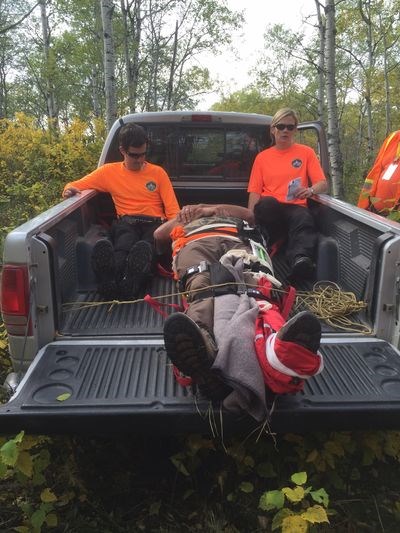The Canora Curling Rink became the command centre for an organized group of search-and-rescue professionals September 16 to 18.
Parkland Search and Rescue Saskatchewan Association of Volunteers (SARSAV) held a multi-jurisdictional search exercise in order to hone the skills of a group of dedicated volunteers. Though the search was held in Canora and the surrounding area, the event brought in members from multiple areas across the province, including Yorkton, La Ronge, Prince Albert, Wadena, Gravelbourg, and Moose Jaw.
Heather Ritchie, the Parkland SARSAV local president, expected about 35 volunteers to attend the exercise, but in fact, discovered that 50 people attended training at different points.
While the command centre was based out of the Canora Curling Rink, the actual search was taking place up to 20 miles west of Canora. At that location, five separate teams conducted grid road searches in an attempt to find the locations of the two men playing the missing people for the exercise.
As the Parkland SARSAV branch is based out of Yorkton, the organization worked in conjunction with the Yorkton branch of the Civil Air Search and Rescue Association (CASARA) at the Yorkton airport. The organization had three planes searching from the air for the missing people, as well as navigators and spotters. Joining them were two members of the RCMP specializing in search-and-rescue operations.
The training exercise began on September 16, with the volunteers receiving training regarding searching near water. The following day, the official exercise began with a debriefing at the Sylvia Fedoruk Centre.
“Our volunteers got all the information they needed for the search,” said Patrick Casement, one of the communications officers with SARSAV. “They got pictures, physical descriptions of the two men, a description of the truck, and the location and time the missing people were last seen.”
For the exercise, two hunters were said to have gone out hunting on the afternoon of September 16. They were hunting in the Whitesand River area, and had not returned. CASARA began with an air search of the area, but it had not located the truck, so five ground teams were sent out to locate the truck.
Once the truck was found, a group of hunters hypothesized where the hunters would have travelled to from that location.
“Hunters don’t stray any farther than two kilometres from their vehicle in normal circumstances, so we started with a search in that two-kilometre radius,” Casement said.
Ritchie said the exercise went extremely smoothly, with the searchers only taking four and a half hours to locate the truck and half an hour more to locate the hunters. One of the missing people was said to be injured, so the team also provided first aid and helped him onto a stretcher.
The five teams were able to communicate with the rest of the volunteers through the command centre, where communications officers were able to communicate with mobile stations around the search area.
“It’s sort of a game of telephone,” Casement said. “We contact the mobile stations since they’re in range, and they contact the teams searching.”
The command centre relayed all calls from the mobile station, mobilized the teams, mapped out locations, and recorded all information necessary for the search. Paperwork needed to be done so it could be given to the RCMP during and after the search. Every minute of the search was tracked through first notice sheets, missing person profiles, incident history, team debriefing notes, resource lists, and communication logs. Media releases were also written by communications officers and RCMP members to notify the public of the search’s progress.
Part of the reason the training exercise was organized, Casement said, is in order to become familiar with the search-and-rescue equipment. Due to a federal grant known as the Community Initiatives Fund, Parkland SARSAV was able to purchase new radio equipment in May. The objective was to deal with radio glitches and also discover the area that each radio can reach.
The other reason, of course, was to provide training for the valuable volunteers in the SARSAV program. SARSAV covers 17 chapters with over 500 trained volunteers.
“Volunteers give up a lot of time and don’t get paid, but their work is necessary. It’s a partnership of a lot of different people who need to cover a lot of different areas.
“On a small search, I need to wear a lot of different hats and cover different roles,” Casement said.
Ritchie agreed, adding that for every three volunteers searching the area, there is at least one supporting volunteer who handles debriefing, communications, cooking, and so on. All of those volunteers need organization, which is why SARSAV was created to ensure search-and-rescue volunteers were professionally trained.
SARSAV was created due to a missing persons case in 1994. A girl named Ashley Krestianson went missing south of Tisdale, which summoned a huge group of volunteers who wished to search for her. Over 600 people were involved in the search, but it was disorganized and difficult to mobilize such a large group.
“The massive search spawned the development activity in communities with the goal of providing volunteers to assist the RCMP should such an incident happen again. The RCMP in turn realized they would need to have trained people to help with such a search. The RCMP and representatives from the communities met and SARSAV became an entity,” said information from the SARSAV website.
The organized event in Canora was meant to ensure the training SARSAV is known for would continue, and one Parkland SARSAV member, Ian MacNeil of Laloche, says over the next 18 months, several training exercises will take place.
“We’re moving up to a CSA standard,” he said.
The Parkland SARSAV training event also featured a night search exercise and landing zone training for Shock Trauma Air Rescue Society (STARS).




